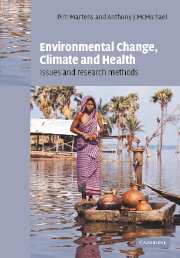Book contents
- Frontmatter
- Contents
- List of contributors
- Foreword
- 1 Global environmental changes: anticipating and assessing risks to health
- 2 Historical connections between climate, medical thought and human health
- 3 The contribution of global environmental factors to ill-health
- 4 Surprise, nonlinearity and complex behaviour
- 5 Epidemiological and impacts assessment methods
- 6 Retrospective studies: analogue approaches to describing climate variability and health
- 7 Detecting the infectious disease consequences of climate change and extreme weather events
- 8 Integrated Assessment modelling of human health impacts
- 9 Remote sensing, GIS and spatial statistics: powerful tools for landscape epidemiology
- 10 Monitoring the health impacts of global climate change
- 11 Epidemiology, environmental health and global change
- 12 Dealing with scientific uncertainties
- Index
- Plate section
- References
1 - Global environmental changes: anticipating and assessing risks to health
Published online by Cambridge University Press: 28 July 2009
- Frontmatter
- Contents
- List of contributors
- Foreword
- 1 Global environmental changes: anticipating and assessing risks to health
- 2 Historical connections between climate, medical thought and human health
- 3 The contribution of global environmental factors to ill-health
- 4 Surprise, nonlinearity and complex behaviour
- 5 Epidemiological and impacts assessment methods
- 6 Retrospective studies: analogue approaches to describing climate variability and health
- 7 Detecting the infectious disease consequences of climate change and extreme weather events
- 8 Integrated Assessment modelling of human health impacts
- 9 Remote sensing, GIS and spatial statistics: powerful tools for landscape epidemiology
- 10 Monitoring the health impacts of global climate change
- 11 Epidemiology, environmental health and global change
- 12 Dealing with scientific uncertainties
- Index
- Plate section
- References
Summary
Introduction
The meaning of the word “environment” is elastic. Conventionally it refers to the various external factors that impinge on human health through exposures common to members of groups, communities or whole populations, and that are typically not under the control of individuals (i.e. the exposures are predominantly involuntary). Thus, “environmental exposures” are usually thought of as physical, chemical and microbiological agents that impinge on us from the immediately surrounding (ambient) environment.
The “environmental” roles of socioeconomic status in the determination of disease patterns, including aspects such as housing quality and material circumstances, have also claimed increasing attention from health researchers. This, however, requires a more inclusive definition of “environment” – one that embraces social and economic relations, the built environment and the associated patterns of living.
Note also that we typically view the environment as being “out there”. It surrounds us, it impinges on us – but it is not us. This implied separateness reflects the great philosophical tradition that arose in seventeenth-century Europe as the foundations of modern empirical western science were being laid by Bacon, Descartes, Newton and their contemporaries. For several centuries this view helped us to manage, exploit and reshape the natural world in order to advance the material interests of industrializing and modernizing western society. In recent times, however, the magnitude of that environmental impact by human societies has increased exponentially.
- Type
- Chapter
- Information
- Environmental Change, Climate and HealthIssues and Research Methods, pp. 1 - 17Publisher: Cambridge University PressPrint publication year: 2002



